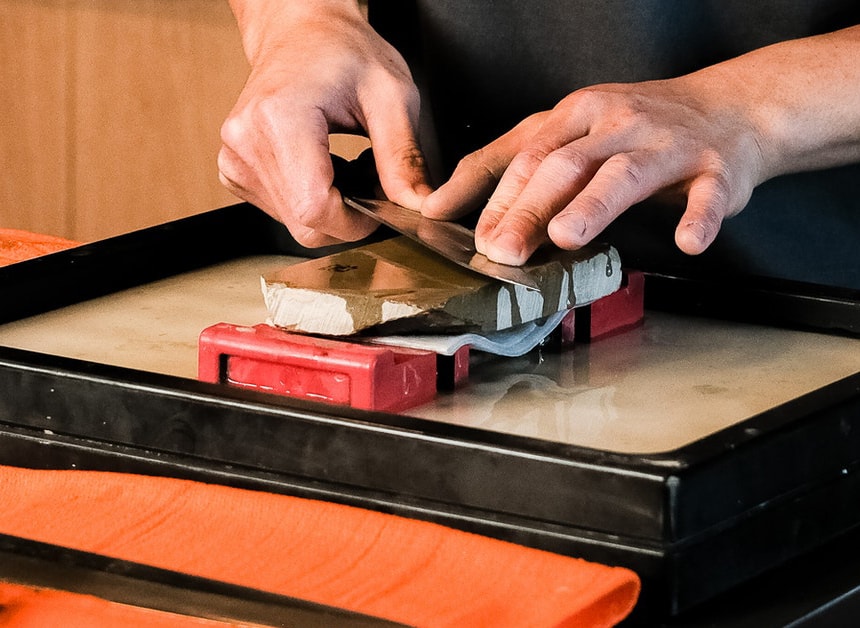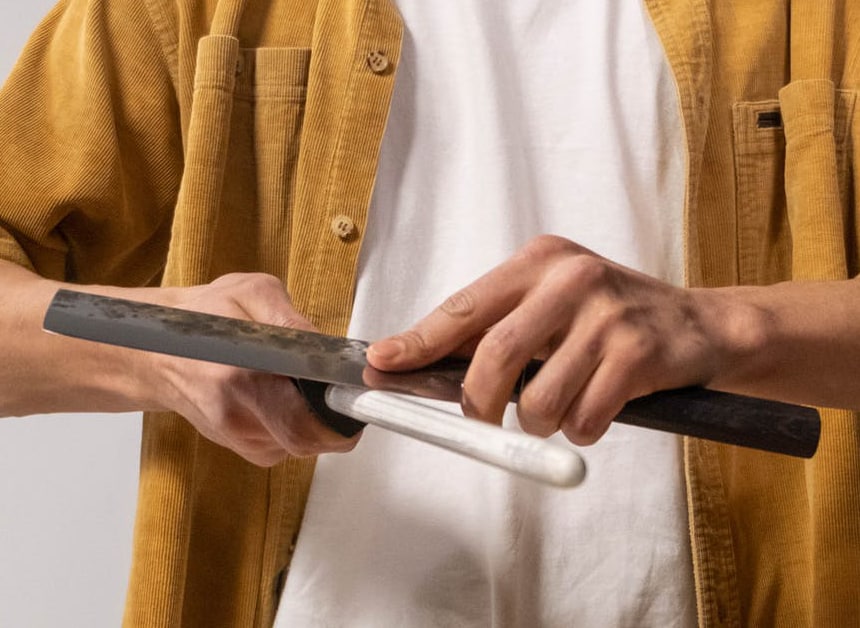
Keeping knives clean, sharp and ready to use will make your time in the kitchen easier and more fun. Hone your knives often, sharpen them when blunt, and consider using a professional sharpening service a couple of times each year for optimum performance.
Knives should be sharpened when they become blunt and their performance cannot be restored by honing. Experts recommend sharpening knives every one to two months and having them professionally sharpened every year or two. Between sharpenings, knife blades can be honed daily to keep blades in good condition.
To learn more about the difference between honing and sharpening a knife and view our tool recommendations, check out our article here (opens new tab).
Looking for a new sharpening rod?
I recommend this Messermeister ceramic rod. You can view it on Amazon here (opens new tab).
Why you need to sharpen knives
When viewed under a microscope, you can see that a sharp knife has a clear, crisp edge, with many tiny peaks and valleys. These tooth-like structures generate a lot of friction as they move across the surface of food, tearing it open and allowing it to be easily split into pieces.
If you now look at the cutting edge of a dulled knife under a microscope, you will see that it is more rounded and smooth than a sharp edge. This means that there is little friction when it’s applied to the surface of food, making it hard to break the surface of the food and cut it cleanly.
Once a knife blade becomes blunt, it can no longer carry out its cutting and chopping tasks easily and effectively. Cutting food with a blunted blade requires additional effort from the cook and may produce a sub-optimal result (e.g. squashed tomato) due to the additional pressure required to force the blade through the food item.
A dull, blunted knife may also be a dangerous tool to handle. If you’re putting additional pressure on your knife and it slips due to its lack of friction and grip on the food surface, it could cut you more deeply than if you’re exerting only light pressure.
Sharpening is the way to restore the blades of your knives to their optimum working condition, bringing back ‘teeth’ to the blade and making it functional and safe to work with again.
Should you sharpen your knife every time you use it?
You do not need to sharpen your knife after every use. This practice could actually damage your knives and shorten their working life. To keep blades keen between sharpenings, you can ‘hone’ their edges with a honing steel.
Honing tools essentially push the ‘teeth’ on the microscopic edges of the knife blade back towards the center, straightening it. The process of honing doesn’t technically sharpen the knife, but if performed correctly, the blade will seem sharper and give a better cutting performance because its edge is now aligned in the best position.
Honing does not remove material from the knife and can be done often to maintain knife condition. Some chefs prefer to hone before each use.
Steel honing rods should not be confused with steel or diamond sharpening rods. While they might look similar to the untrained eye, regular use of a sharpening rod could grind a lot of steel from the edge of your knife if used too often.
Is professional knife sharpening worth it?
Some experts recommend having your kitchen knives professionally sharpened every one to two years, with home maintenance, honing and sharpening in between.
Professional knife sharpeners are likely to have more knowledge, better tools and better technique than most domestic cooks with a basic sharpening steel, whetstone or electric sharpener. This means that professionals can often restore a sharp cutting edge more quickly, to a higher standard, and with less risk of damage, than you are likely to achieve at home.
To get a cutting edge right, it’s important to sharpen at the correct angle, with a controlled pressure. If your angle is too high, you might end up blunting the blade. If your steel, whetstone or sharpening device are too coarse, or you use too much pressure while sharpening, friction could damage or break your knife.
Where to get knives sharpened
Depending on where you live, you may have several options for having knives sharpened professionally. You can probably find a range of local services in your area online with a simple search. Some knife sharpeners will visit your premises, whether at home or in a restaurant or cafe, and then either sharpen your knives on-site, or take the knives away to their workshop.
Other professional services will have a shop or workshop you can visit with your knives, with sharpening carried out on site, possibly while you wait. In some parts of the world, there are also sharpening services that operate by mail, allowing you to send and receive knives in the post, packaged in special boxes.
You may also be able to source personal recommendations for knife sharpening services from friends, neighbors or local restaurants.
Can you sharpen a knife too much?
You can sharpen a knife too much, especially if you use an incorrect sharpening tool or apply too much pressure to the blade. Each time a blade is sharpened, small amounts of metal are removed from it. The more pressure or abrasion you use, the more material you remove, gradually shortening your knife’s life span.
Any sharpening device which produces sparks during sharpening is likely to be damaging your knife. Visible sparks are tiny pieces of overheated metal being thrown off the blade and indicate that the grinding edge of the sharpener is overheating the knife-edge which ‘detempers’ or weakens it.
To get the longest use from your knives at home, you should only sharpen the blades when necessary. Make sure you use a sharpening device suitable for the type and quality of knives in your kitchen. An expensive knife set and a poor-quality sharpener is a foolish combination.
How long does knife sharpening last?
There are many variables that influence how quickly a knife dulls. How often you use the knife, the type of food you chop, the material of your cutting board, and how hard you strike against the board with your blade, are all relevant factors.
Cutting board material has more impact on knife-edge dulling than the actual food chopped. Hard boards (e.g. glass, granite, marble) do dull knives much faster. Plastic and wood chopping boards are easier on knife blades and let them stay sharper for longer.
As a rough guide, a knife will need sharpening every one to two months. If you feel that your knife is becoming less sharp more often, you should first try honing the blade. Proper honing can extend the time before you need to sharpen a knife. If honing doesn’t give an improved result, it is probably time for sharpening.
Do professional chefs sharpen their knives?
Professional chefs keep their knives sharp through regular honing and sharpening as a normal part of their job. Many also use a professional sharpening or cutlery service as required. Professional sharpeners are more likely to have a belt machine that gives a quick, reliable and high-performance result but requires too much space and skill for individuals to own themselves.
Not all knives are suitable for belt machine sharpening, and some require specialized handling. Single-bevel knives (e.g. sashimi knives) must be hand-sharpened on a stone. Check the knowledge and skill of any sharpening or cutlery service before you use them.
How often do professional chefs sharpen their knives?
There is no single sharpening schedule used by all chefs. Most professional chefs sharpen their knives whenever they need sharpening, and this will depend on the level of daily use, chopping surface hardness, and the quality of the knives. Weekly, monthly or yearly might all be feasible in different situations.
Chefs will always hone their knives at least daily, or even after each use in many cases.

